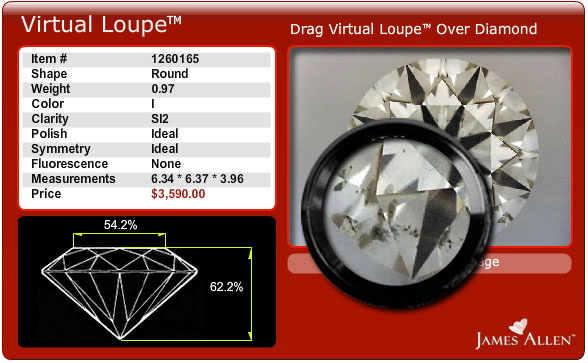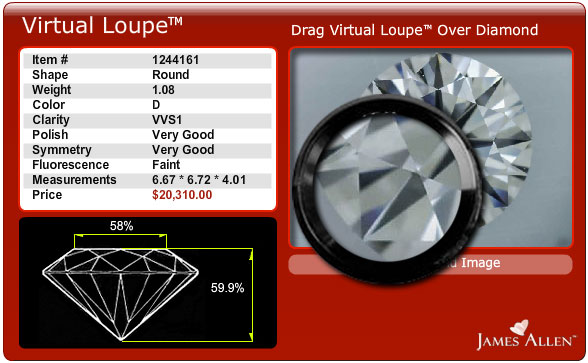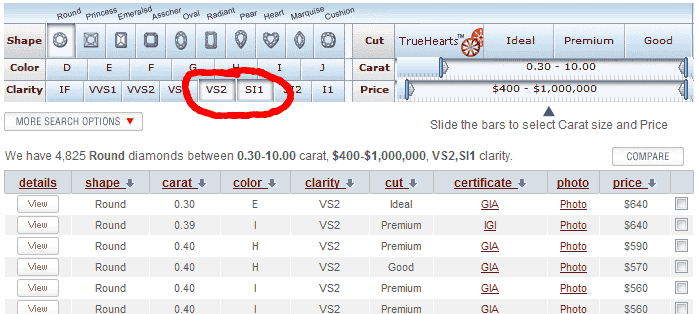Diamond Clarity
Diamond clarity refers to how 'clear' a diamond is - whether it has any defects like scratches or 'inclusions' - bits of other minerals 'included' in the diamond. Obviously, the less of these, the better the diamond looks.
Sponsored Links
The table below describes the clarity grading system. One of the standard ways of describing clarity gradings is to explain whether the defects can be seen with the naked eye, or under a 10x magnification eyepiece.

|
Diamond Clarity Grade
|
Description |
|
FL-IF
|
These are rare, 'perfect' diamonds, as far as clarity is concerned. |
|
VVS1-VVS2
|
Even with a 10x magnifier, you may not be able to see any defects, especially if you're not a trained jeweller. "VVS" stands for Very, Very Slightly included. |
|
VS1-VS2
|
Usually defects in these diamonds are not visible to the naked eye, and to the untrained eye they may or may not be visible under a 10x magnifier. "Very Slightly Included". |
|
SI1-SI2
|
"Slightly Included". Often you will be able to see flaws in these diamonds with the naked eye, but not always. If you search around online you will find many stories of people who've bought SI diamonds from stores which had no flaws visible to the naked eye. A little more caution is needed though if you're buying one online without being able to see it.
|
|
I1 - I3
|
These are 'Included' diamonds and will have flaws visible to the naked eye. You'll find these in jewellers as diamonds which are quite affordable for the size.
|
|
Below I
|
Below 'Included' are diamonds with very obvious inclusions or flaws. These diamonds can still be found in stores and are (usually) a lot cheaper than you would expect, until you realise the clarity grade. |
For those on a budget and buying in a store, VS or SI diamonds are great because you can check them yourself to see whether you're happy with the visibility of any inclusions. Buying online, if you want to play it safe, you probably need to aim for at least a VS2 grade. Some online stores will let you phone in and get them to eyeball the specific diamond you're interested in to see whether anything's visible. Just remember though that you're trusting that their opinion is going to be the same as yours!
Actual Photos of Diamonds
James Allen has actual photos of almost every diamond they sell - that's more than 15,000 actual diamond photos. This gives you, the buyer, a huge advantage because you can actually have a look at an actual real photo, rather than an illustration of text description of the diamond.
The photo technology James Allen uses is great too because you can zoom in on the diamond photos, to see every last detail. I've put some example pictures below to show you what I mean. You can also have a browse of the diamond photos yourself by finding a diamond using the diamond search tool here, and then clicking on the "Real Diamond Photo" image for a closer look.

This is an SI2 diamond, and using the magnification tool you can see small specks representing the inclusions in the diamond. Remember that this diamond is only 6 mm across, so the inclusions are really quite small, but definitely visible.

This is a VVS1 diamond, and even using the magnification tool you can't see any inclusions. This is a really high quality diamond with respect to clarity.
You can browse lots of photos of diamonds to get an idea of what sort of inclusion level would be acceptable for you by using the James Allen diamond search tool, available here. I've circled in red the part of the search tool where you select what inclusion levels you're interested in - in this example, I've selected "VS2" and "SI1" - see the table above for an explanation of these terms.


